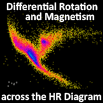Speaker
Rafael A. Garcia Garcia
(Laboratoire AIM, CEA/DSM-CNRS-Université Paris)
Description
Continuous photometric coverage of stars provided by asteroseismic space missions,
are a great opportunity to study their surface rotation and stellar variability. In
particular, long and uninterrupted Kepler observations of more than 3.5 years allows
us to study stellar activity cycles of many stars. A surface stellar activity proxy
can be built from the variance of the light curve as the spots crossing the visible
disk of stars produce a modulation in stellar photometry. The higher the number of
spots is, the larger the variance. Moreover, in a few dozens of fast rotating stars,
we have also access to acoustic modes. We can then study the perturbations induced
below the surface by the magnetic cycle in the properties of the modes, such as their
amplitudes and frequencies. Although solar-like stars can have magnetic activity
cycles longer than the length of current asteroseismic observations performed with
CoRoT and Kepler, several authors have suggested a relation between the length of the
cycles and the rotation period. Therefore, for rapidly rotating (young) stars, the
cycles can be of a few years and therefore accessible to our current measurements. In
this talk we propose to review some of the open questions we have and how CoRoT and
Kepler measurements, with the support of ground based observations, are shedding new
light onto this field.
Authors
Allan Sacha Brun
(Laboratoire AIM Paris-Saclay, CEA/Irfu Université Paris)
Clara Regulo
(Instituto de Astrofísica de Canarias, La Laguna)
David Salabert
(CNRS, Observatoire de la Côte d'Azur, Nice)
Jerome Ballot
(CNRS, Institut de Recherche en Astrophysique et Planétologie, Toulouse)
Kyle Augustson
(ILA and Department of Astrophysical & Planetary Sciences, University of Colorado, Boulder)
Rafael A. Garcia Garcia
(Laboratoire AIM, CEA/DSM-CNRS-Université Paris)
Savita Mathur
(High Altitude Observatory, NCAR, Boulder)
Stephane Mathis
(Laboratoire AIM Paris-Saclay, CEA/Irfu Université Paris)
Travis S. Metcalfe
(Space Science Institute, Boulder)
Tugdual Ceillier
(Laboratoire AIM, CEA/DSM CNRS - Univ. Paris)

